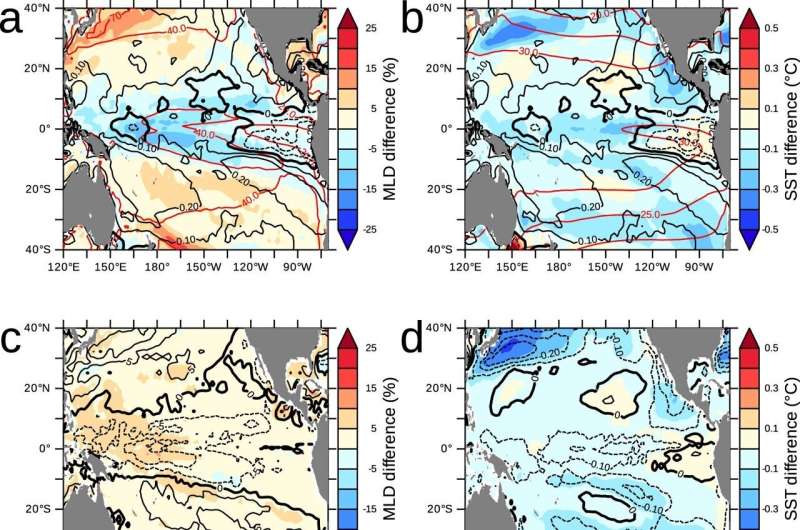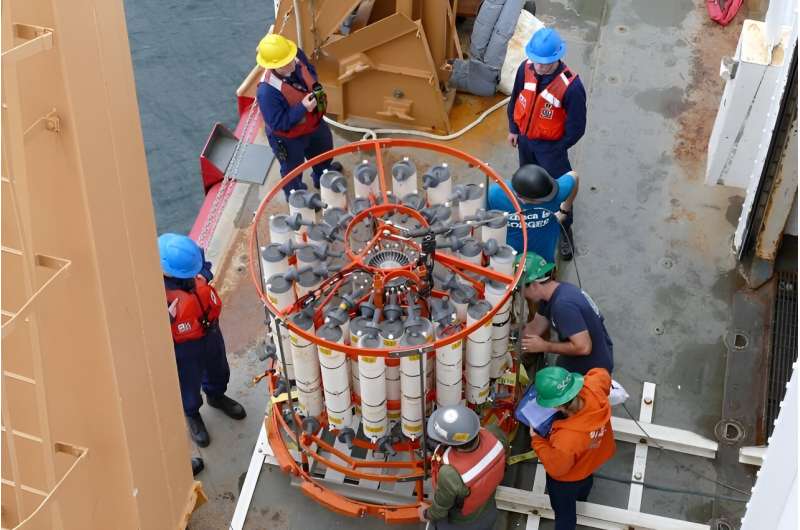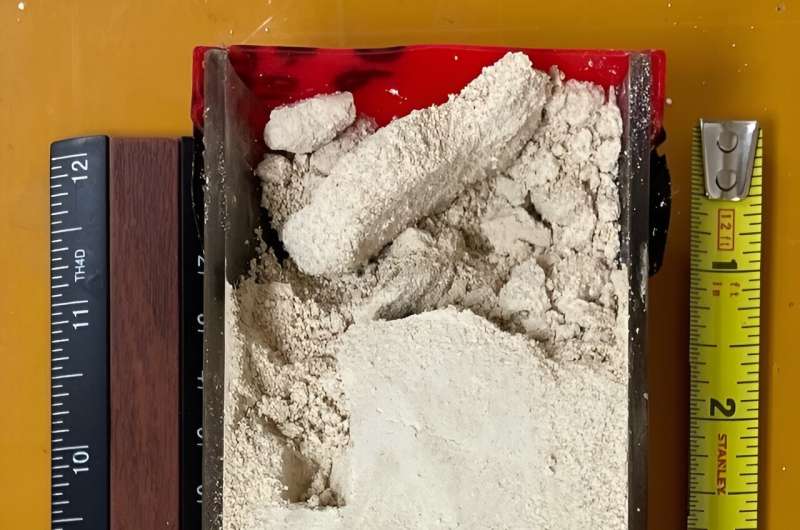Study investigates impact of extreme weather events on ocean circulation in tropical Pacific

The strength of the wind has an important influence on ocean circulation. This is particularly true for extreme events such as storm fronts, tropical storms and cyclones. These weather patterns, which last from a few days to a few weeks, will change in the future due to climate change. In particular, the average energy input into the ocean from mid-latitude storms is expected to decrease, while equatorial regions will become more active. Scientists call these different weather patterns "Atmospheric Synoptic Variability" (ASV).
Two climate researchers—Dr. Olaf Duteil from the GEOMAR Helmholtz Center for Ocean Research Kiel and Professor Dr. Wonsun Park from the IBS Center for Climate Physics and Pusan National University, Korea—have now for the first time investigated the integrated effects of long-term changes in these weather patterns on the Pacific basin in a modeling study. The results show how important it is to take these changes into account in climate models. They have now published their findings in the journal npj Climate and Atmospheric Science.
From a climate point of view, the weather is usually considered as "noise" and is not systematically analyzed in long-term climate projections, say the two researchers. "However, it is not enough to look at average atmospheric properties, such as mean wind speeds, to understand the influence of climate change on the ocean," says Duteil, "it is crucial to consider the cumulative effect of short-term changes in weather patterns to get a complete picture."
The researchers expect that future changes in Atmospheric Synoptic Variability will affect the mixing of the ocean's layers, as a smaller or larger input of kinetic energy into the ocean due to weather phenomena will lead to less or more mixing, respectively. The researchers predict that the reduction in ASV in subtropical regions will lead to a shallowing of the mixing layer in the ocean, while it will become deeper at the equator as ASV increases
They also show that a future reduction in ASV decreases the strength of oceanic circulation systems—the so-called subtropical and tropical cells—and the large-scale ocean circulation. These systems connect mid-latitudes and equatorial latitudes via upper ocean pathways. They are driven by the trade winds north and south of the equator, regulate the upwelling of equatorial waters and play a fundamental role in determining the surface temperature of the oceans and thus primary productivity in the tropics.
This study highlights the need to better quantify ASV and weather patterns in climate models, as changes in ASV have a large impact on future upper ocean circulation and mean properties. Duteil states, "This quantification should be used to improve our confidence in projections of future climate, especially when analyzing large ensembles of climate models."
More information: Olaf Duteil et al, Future changes in atmospheric synoptic variability slow down ocean circulation and decrease primary productivity in the tropical Pacific Ocean, npj Climate and Atmospheric Science (2023).
DOI: 10.1038/s41612-023-00459-3
Journal information: npj Climate and Atmospheric Science
Provided by Helmholtz Association of German Research Centres Examining how weather patterns will change in the future
Research reveal large swings in past ocean oxygen

As the climate warms, there is major concern that Earth's ocean will lose oxygen. A study published in Geophysical Research Letters by oceanographers at the University of Hawai'i at Mānoa revealed that locked in ancient deep-sea sediments is evidence for oxygen loss in the world's ocean during past glacial periods, indicating that widespread oxygen loss with current climate change may not be permanent.
Scientists first measured oxygen in the oceans in the 1960s. Since then, they have observed decreasing levels in the mid-depths of the ocean—a phenomenon that can be explained in part by the fact that warmer waters hold less oxygen. Less oxygen in the water can lead to habitat loss for fish and other marine species that need oxygen to breathe. If the naturally-occurring low-oxygen regions in the Eastern Pacific expand in a warmer climate, Pacific Island fisheries could be significantly impacted.
Cobalt holds the clues in deep-sea sediments
"Ultimately, it would be helpful if we knew how low-oxygen regions of the ocean changed with past climate changes," said Nick Hawco, lead author of the study and assistant professor of oceanography, in the UH Mānoa School of Ocean and Earth Science and Technology (SOEST).
"However, the problem is that oxygen is a gas, so we don't have any reservoirs of past oceans to test the oxygen content. Our new study builds off of prior work where we discovered that low oxygen water bodies in the Pacific are enriched in the metal cobalt."
"One of the biggest sources of cobalt to the oceans is where oxygen deficient zones intersect with the continental shelf, leach cobalt from the shelf, and then transport it across the ocean in a plume of low oxygen water," said Rhea Foreman, study co-author and oceanography researcher in SOEST. "The cobalt is subsequently incorporated into minerals that are deposited onto the seafloor and preserved in the sedimentary record."

The researchers analyzed seafloor sediments from the past 145,000 years, a timeframe that includes the last major ice age. They found more cobalt in sediments from the past ice ages, compared to more recent sediments.
"This means that there was a build up of cobalt in the Pacific during the last ice age," said Hawco. "Because high cobalt is a proxy, or a stand-in, for low oxygen, this indicates there were probably larger regions of low oxygen waters in the Pacific during that time."
Time to adapt
One suggested explanation for low-oxygen waters being more common in cold climates is the change in ocean circulation that accompanies climate change. Today, complex currents flowing from west to east help add oxygen to the mid-depth waters of the tropical Pacific.
"If these currents weaken, the oxygen in the Pacific would decline," said Hawco. "This is what we think happened during the last glacial period. But we don't know how strongly—or how fast—these currents will respond to ocean warming."
This could mean that fish and other species are able to adapt to changing oxygen as long as these changes are slow enough, as appears to have happened in the past.
"We need to reduce emissions as soon as possible to buy time for these ecosystems to adapt to the climate change we are already locked into based on the last 150 years of carbon emissions," added Hawco.
More information: Nicholas J. Hawco et al, Expansion of Ocean Anoxia During Glacial Periods Recorded in the Cobalt Flux to Pelagic Sediments, Geophysical Research Letters (2023). DOI: 10.1029/2023GL105135
Journal information: Geophysical Research Letters
Provided by University of Hawaii at Manoa There may be good news about the oceans in a globally warmed world
No comments:
Post a Comment